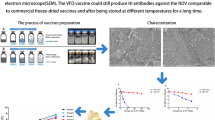Abstract
I–2 is an avirulent strain of Newcastle disease virus. During establishment of the I-2 strain master vaccine seed, a series of selection procedures was carried out at 56°C in order to enhance heat resistance. This master seed is used to produce a working seed, which is then employed to produce the vaccine. These two passages are done without further heat selection; however, it is not known how rapidly and to what extent thermostable variants would be lost during further passage. The study was therefore conducted to determine the effect of passage on thermostability of strain I-2. The virus was serially passaged and at various passage levels samples were subjected to heat treatment at 56°C for 120 min. The inactivation rates for infectivity and haemagglutinin (HA) titres were assayed by use of chicken embryonated eggs and HA test, respectively. Thermostability of HA and infectivity of I-2 virus were reduced after 10 and 5 passages, respectively, without heat selection at 56°C. These results suggest that 5 more passages could be carried out between the working seed and vaccine levels without excessive loss of thermostability. This would result in increased vaccine production from a single batch of a working seed.
Similar content being viewed by others
Abbreviations
- EID50 :
-
median embryo infective dose
- NDV:
-
Newcastle disease virus
- NDV:
-
Newcastle disease virus
- PBS:
-
phosphate-buffered saline
- RBC:
-
red blood cells
References
Alexander, D.J., 1988. Newcastle disease diagnosis. In: D. J. Alexander (ed.), Newcastle Disease, (Kluwer, Boston), 145–160
Alexander, D.J., 1998. Newcastle disease. In: D.E. Swayne, J.R. Glisson, M.W. Jackwood, J.E. Pearson, W.M. Reed (eds), A Laboratory Manual for Isolation and Identification of Avian Pathogens, 4th ed., (American Association of Avian Pathologists, Kennett Square, PA), 156–163
Allan, W.H. and Gough, R.E., 1976. A comparison between the haemagglutination inhibition and complement fixation tests for Newcastle disease. Research in Veterinary Science, 20, 101–103
Bensink, Z. and Spradbrow, P., 1999. Newcastle disease virus strain I-2-a prospective thermostable vaccine for use in developing countries. Veterinary Microbiology, 68, 131–139
Dutcher, R.M., Read, R.B. and Litsky, W., 1960. The immunological antigenicity of rapid heat inactivated viruses. I. Newcastle disease virus. Avian Diseases, 4, 205–217
Goldman, E.C. and Hanson, R.P., 1955. The isolation and characterization of heat-resistant mutants of the Najerian strain of NDV. Journal of Immunology, 74, 101–105
Hiatt, C.W., 1964. Kinetics of inactivation of viruses. Bacteriology Reviews, 28, 150–163
King, D.J., 2001. Selection of thermostable Newcastle disease virus progeny from reference and vaccine strains. Avian Diseases, 45, 512–516
Lomniczi, B., 1975. Thermostability of Newcastle disease virus strains of different virulence. Archives of Virology, 47, 249–255
Pierce, J.S. and Haywood, A.M., 1973. Thermal inactivation of Newcastle disease virus. I. Coupled inactivation rates of haemagglutinating and neuraminidase activities. Journal of Virology, 11, 168–176
Reed, L.S. and Muench, L.H., 1938. A simple method of estimating fifty percent endpoints. American Journal of Hygiene, 27, 493–497
Spradbrow, P.B., 1992. A review of the use of food carriers for the delivery of oral Newcastle disease vaccine. In: P.B. Spradbrow (ed.), Newcastle Disease in Village Chickens, Control with Thermostable Oral Vaccine, (ACIAR Proceedings No. 39), 18–20
Spradbrow, P.B., Mackenzie, M. and Grimes, S.E., 1995. Recent isolates of Newcastle disease virus. Vetennary Microbiology, 46, 21–28
Varadarajan, V., Tanwani, S.K., Moghe, M.N. and Sharda, R., 2000. Vaccines against Newcastle disease virus using thermostable derivatives of lentogenic strains. Indian Veterinary Journal, 77, 1021–1024
Author information
Authors and Affiliations
Corresponding author
Rights and permissions
About this article
Cite this article
Wambura, P.N., Meers, J. & Spradbrow, P.B. Thermostability profile of Newcastle disease virus (strain I–2) following serial passages without heat selection. Trop Anim Health Prod 38, 527–531 (2006). https://doi.org/10.1007/s11250-006-4348-x
Accepted:
Published:
Issue Date:
DOI: https://doi.org/10.1007/s11250-006-4348-x




